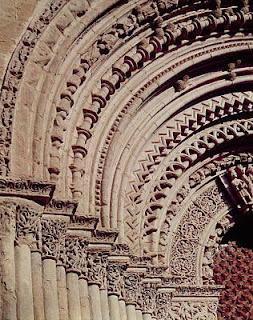ANGELS
فرشتے
اسلام میں فرشتوں پر اعتقاد کلیدی حیثیت رکھتا ہے۔ قرآن مجید میں ، لفظ فرشتہ (عربی: ملیک 'ملوک') ملاکا سے آیا ہے ، جس کا مطلب ہے "فرشتوں کی مختلف کاموں کو سنبھالنے کی اہلیت کی وجہ سے ،" "کنٹرول" تھا ، یا 'ایلک ، ایل - کے' یا جڑ سے شروع ہوتا ہے ، جس کا مطلب ہے "میسنجر" ، جیسا کہ عبرانی (ملʾáک) اور یونانی (انجلوس) میں ہے۔ عبرانی ورژن کے برعکس ، اس اصطلاح کا اشارہ خصوصی طور پر آسمانی دنیا کے آسمانی روحوں سے ہے ، لیکن کبھی بھی انسانی میسنجروں سے نہیں۔ اس کے بجائے ، قرآن فرشتہ اور انسانی میسنجروں کے لئے "رسول" کی اصطلاح استعمال کرتا ہے۔
قرآن مجید اسلامی فرشتوں کے خیال کا بنیادی ماخذ ہے۔ ان میں سے کچھ ، جیسے جبرائیل اور مائیکل ، قرآن میں ان کے اپنے ناموں کی نمائندگی کرتے ہیں ، جبکہ دوسروں کی نمائندگی ان کے فنکشن سے ہوتی ہے۔ حدیث ادب میں ، فرشتے اکثر صرف ایک خاص واقعے سے وابستہ ہوتے ہیں۔ فرشتے میرج ادب میں ایک اہم کردار ادا کرتے ہیں ، جہاں محمد اپنے جنت کے سفر کے دوران متعدد فرشتوں سے ملتے ہیں۔ دوسرے فرشتوں کو اکثر اسلامی اسکچالوجی ، اسلامی الہیات اور فلسفہ میں پیش کیا جاتا ہے۔ فرشتوں کو دیئے گئے کاموں میں سے ، مثال کے طور پر ، خدا کا نزول ، خدا کی تسبیح ، انسانی افعال کی ریکارڈنگ ، اور موت کے وقت انسانی روح سے بات کرنا۔
اسلام میں ، یہودیت اور عیسائیت کی طرح ، فرشتوں کو اکثر انسانی فطرت میں مافوق الفطرت عناصر ، جیسے خامیوں ، بڑے طول و عرض یا آسمانی صفات کی نمائندگی کی جاتی ہے۔ قرآن نے ان کو "نمبر والے پیغامبر۔ دو یا تین یا چار (جوڑے) کے طور پر بیان کیا ہے۔ وہ [خدا] اپنی تخلیق کو جس طرح چاہتا ہے شامل کرتا ہے ..." فرشتوں کی عمومی خصوصیات ان کی جسمانی خواہشات کی کمی ہے ، جیسے۔ کھانا پینا۔ مادی خواہشات کا فقدان اس سے یہ ظاہر ہوتا ہے کہ وہ نور سے پیدا ہوئے ہیں۔ فرشتوں کو نور (ٹھنڈے روشنی) سے پیدا کیا گیا ہے ، سزا کے فرشتوں کے برخلاف ، نار (گرم روشنی) سے پیدا کیا گیا ہے۔ عام طور پر مسلمان قبول نہیں کرتے فرشتوں کے بارے میں تاثرات ، جیسے مغربی فن میں بھی ہے۔
ابن سینا ، جنہوں نے نیوپلاٹونک نزول کے الفارابی کی کائناتولوجی کو واضح کیا ، نے فرشتہ کی طرف سے تخلیق کردہ ذہانت کی فرشتہ کی ترقی کی۔ لہذا ، خدا کی تخلیق کردہ سب سے پہلے مخلوق اعلی مجاہد ہے ، اور اس کے بعد دوسرے عہدے دار کم عقل والے ہیں۔ ان عقائد سے نچلے فرشتوں ، یا "متحرک دائرہ" پیدا ہوتا ہے ، جہاں سے دوسرے عقائد سامنے آجاتے ہیں ، یہاں تک کہ وہ اعلی دانشور تک پہنچ جائیں ، جس پر روحوں کا راج ہے۔ دسویں عقل مادی مخلوق کو زندہ کرنے اور ان کے ذہنوں کو روشن کرنے کے لئے ذمہ دار ہے۔
کچھ جدید اسکالرز فرشتوں کے خیال کی علامتی تشریح پر زور دیتے ہیں۔
ANGELS
Belief in angels is key in Islam. In the Qur'an, the word angel (Arabic: ملك 'malak') comes from either Malaka, which means "he controlled" due to the angels 'ability to handle various tasks, or' -lk, l -'- k or from the root mlk, which means "messenger", as in Hebrew (malʾákh) and Greek (angelos). Unlike the Hebrew version, the term refers exclusively to the heavenly spirits of the divine world, but never to human messengers. Instead, the Qur'an uses the term "rasul" to refer to angelic and human messengers.
The Qur'an is the main source of the idea of Islamic angels. Some of them, like Gabriel and Michael, are represented in the Qur'an by their own names, while others are represented by their function. In the hadith literature, angels are often associated with only one particular event. Angels play an important role in Mirage literature, where Muhammad meets several angels during his journey to heaven. Other angels are often depicted in Islamic eschatology, Islamic theology, and philosophy. Among the assignments given to angels are, for example, the revelation of God, the glorification of God, the recording of human actions, and the speaking to the human soul at the time of death.
In Islam, as in Judaism and Christianity, angels are often represented in human form with supernatural elements, such as flaws, large dimensions, or celestial attributes. The Qur'an describes them as "messengers with numbers - two or three or four (pairs). He [God] adds to the Creation as He wills ... ” The general characteristics of angels are their lack of carnal desires, such as eating and drinking. Lack of material desires This shows that they were created from light. Angels of Mercy are created from nur (cold light), as opposed to angels of punishment, created from nar (warm light). Muslims usually do not accept the perception of angels in images, as is the case in Western art.
Ibn Sina, who illustrated the cosmology of al-Farabi of Neoplatonic descent, developed the angelic hierarchy of Intellect created by the One. Therefore, the first creature created by God is the supreme archangel, followed by the other archangels with lower intellect. From these intellects arise the lower angels, or "moving spheres," from which other intellects emerge, until they reach the higher Intellect, which is ruled by souls. The tenth intellect is responsible for bringing material beings to life and enlightening their minds.
Some modern scholars emphasize the figurative interpretation of the idea of angels.
Also read








1 Comments
MashAllah informative ✨
ReplyDelete